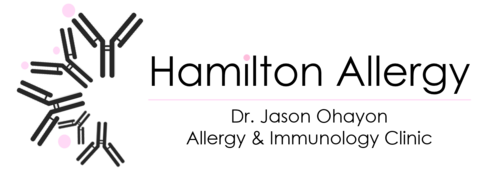Peanut Allergy
Peanuts are part of Health Canada’s priority food allergens, a group of foods that cause the majority (90%) of allergic reactions in Canada. Up to 20% children outgrow their peanut allergy, but for those who do not, there are some new developments on the horizon for treatment:
CURRENT TREATMENT
Unfortunately, we do not have a cure for peanut allergy at the moment. The mainstay of treatment involves avoidance of food that may contain peanuts and treatment of allergic reactions as they occur.
For emergency treatment, many or all of you are aware of epinephrine (i.e. EpiPen, AllerJect,). Be sure to carry your epinephrine autoinjector with you at all times and treat early! If you suspect that you are having an anaphylactic reaction, administer epinephrine immediately then call 911 and inform them that you are having an anaphylactic reaction. If there is no improvement in symptoms after 10 mins, you may administer a second dose of epinephrine if available. Be sure to go to the hospital or call 911 after your first dose of epinephrine. You may use antihistamines only after epinephrine.
Prospective Treatments
ORAL IMMUNOTHERAPY
Peanut Oral Immunotherapy (OIT) is the treatment of peanut allergy by giving your body small, increasing amounts of peanut over a period of months to years. The idea is to slowly introduce your body to peanut so that it begins to recognize peanuts in a more immune tolerant way. The result is your immune system would not “overreact” with allergic reaction when you come into contact with small amounts of peanut. Peanut OIT is successful in 80% of peanut allergic children. Although not a cure, it allows for a degree of daily tolerance to peanut in case of accidental exposure to mitigate any allergic response.
Palforzia is a product that is manufactured from peanuts by Aimmune therapeutics that has been trialed successfully for peanut oral immunotherapy. Our office was part of international network of trial sites that collecting safety data on peanut OIT. It received FDA approval in January 2020 for the mitigation of allergic reactions with peanut. We hope to see Palforzia approved by Health Canada in 2021.
As you are introducing your body to any allergen, peanut OIT does have its risks. This includes side effects such as nausea, abdominal pain, vomiting, cramping and oral itching. In up to 5% of children on OIT if they complain of GI symptoms, a condition known as eosinophilic esophagitis or “EoE” may develop which is an allergic disease of the esophagus. Less likely but possible are symptoms of allergy known to you including rash/hives, facial swelling, wheezing and even anaphylaxis, often triggered by exercise after taking peanut OIT; timing of exercise is important when taking peanut OIT to ensure it is done at least 1.5 hours before exercise.
While on and after peanut oral immunotherapy, it is imperative that you continue to carry your epinephrine autoinjector with you at all times. Peanut oral immunotherapy MUST also be done under the supervision of a healthcare professional such as allergists to ensure your safety. This means an average of a visit to your doctor’s office every 2 weeks to receive peanut over a period of 4-6 months while you “build up” on peanut therapy. Afterwards you carry on with daily therapies at home.
BIOLOGICS AND CLINICAL TRIALS
Biologics are molecules that interact with your immune system to stop undesired immune effects on the body. Biologics have been use to treat allergic diseases for 10-15 years. More novel biologic formations are used to help patients treat and control allergies, now with new trials focused to food allergies.
Dupilumab is a biologic that interferes with the part of the immune system responsible for allergic diseases, now approved for adult and pediatric asthma and atopic dermatitis (eczema). It is now being “trialed” or tested for children with food allergies, including peanut allergies.

